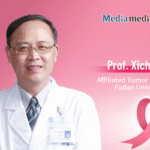
Editor’s Note: On May 29, 2025, the originator, next-generation CDK4/6 inhibitor Lerociclib received approval from China’s National Medical Products Administration (NMPA) for both first-line and second-line indications in HR+/HER2– advanced breast cancer. As a structurally new CDK4/6i, Lerociclib incorporates a tricyclic & spirocyclic scaffold that optimizes pharmacokinetics—featuring low half-maximal inhibitory concentration (IC50) for CDK4, high intratumoral enrichment, and rapid plasma clearance—thereby enabling continuous daily dosing and sustained tumor suppression. Building on these mechanistic innovations, the China-only LEONARDA-1 and LEONARDA-2 trials demonstrated Lerociclib’s efficacy and safety in both first-line and second-line settings for Chinese patients with HR+/HER2– advanced breast cancer, offering a new solution to the long-standing challenge of balancing efficacy with tolerability in CDK4/6 inhibition. Oncology Frontier invited Professor Jing Cheng of Union Hospital, Huazhong University of Science and Technology, to discuss Lerociclib’s continuous target suppression—from mechanism to clinical data—and to provide guidance for its application in practice.01 Oncology Frontier: With Lerociclib now approved in China, what impact will it have on the treatment of HR+/HER2– advanced breast cancer?
Prof. Jing Cheng: For adult patients with HR+/HER2– locally advanced or metastatic breast cancer, Lerociclib has been approved for two indications at once: (1) combined with an aromatase inhibitor as initial endocrine therapy; and (2) combined with fulvestrant for patients whose disease has progressed after prior endocrine therapy—bringing new therapeutic options to the clinic. Structurally, Lerociclib differs markedly from traditional CDK4/6 inhibitors: its tricyclic & spirocyclic design confers higher and more specific selectivity for CDK4, potentially enhancing antitumor activity, reducing off-target effects, and improving safety. In LEONARDA-1, led by Academician Binghe Xu, 276 HR+/HER2– patients with progression after endocrine therapy were randomized 1:1 to Lerociclib + fulvestrant versus placebo + fulvestrant. Investigator-assessed median PFS improved significantly to 11.07 vs 5.49 months, with an HR of 0.451 (P < 0.0001). The favorable hazard ratio indicates broader patient benefit alongside a superior safety profile, garnering wide recognition. I am confident that Lerociclib’s approval will reshape the treatment landscape for HR+/HER2– breast cancer.
02 Oncology Frontier: As a new CDK4/6 inhibitor that requires no dosing holidays and supports continuous administration, what are Lerociclib’s key pharmacokinetic features?
Prof. Jing Cheng: Lerociclib’s pharmacokinetics are characterized by:
High selectivity Lerociclib exhibits more specific selectivity for CDK4 than other CDK4/6 inhibitors and a lower IC50 for CDK4, reflecting stronger inhibitory potency.
High permeability Lerociclib has a larger apparent volume of distribution than peer agents, enabling extensive tissue distribution. It shows marked intratumoral accumulation—tumor exposure is ~18× plasma exposure. At 24 hours post-dose, when plasma levels fall to very low concentrations, intratumoral concentrations remain >100× higher than plasma, achieving deep tissue penetration and enrichment.
Rapid clearance With daily dosing, repeated administration leads to rapid plasma clearance, reducing sustained bone-marrow suppression and supporting continuous therapy.
In terms of clinical evidence, Phase IB/IIA studies showed no PK accumulation, supporting once-daily, continuous dosing. A subsequent Phase II dose-expansion established 150 mg BID, which was then validated for efficacy and safety in Phase III pivotal trials.
03 Oncology Frontier: Many earlier CDK4/6 inhibitors used intermittent dosing to balance efficacy and toxicity. How does Lerociclib’s continuous dosing compare in terms of efficacy, and which patients may benefit most?
Prof. Jing Cheng: Continuous dosing with Lerociclib yields a smoother PK profile, providing sustained target suppression and thereby greater clinical benefit. In LEONARDA-1, Lerociclib + endocrine therapy reduced the risk of progression or death by 54.9% versus endocrine therapy alone (HR 0.451; P < 0.0001), among the most favorable risk reductions reported for CDK4/6 inhibitors. The regular, uninterrupted schedule is also simpler for patients, reducing missed doses or cycle miscalculations and improving adherence. For high tumor burden populations, continuous dosing helps maintain effective drug levels, translating to better outcomes. Subgroup analyses in LEONARDA-1 showed substantial PFS gains in visceral (liver) metastases, primary endocrine resistance, ≥4 metastatic organs, and prior chemotherapy in the recurrent/metastatic setting—all difficult-to-treat cohorts. Lerociclib’s high intratumoral permeability is thus strongly corroborated by clinical results. Across approved CDK4/6 inhibitors, when focusing on these high-risk subgroups, Lerociclib has delivered broad and strong efficacy, with notably favorable hazard ratios.
04 Oncology Frontier: Does continuous dosing increase adverse events or the risk of drug accumulation? How do you assess the safety of this regimen?
Prof. Jing Cheng: Regarding accumulation, Phase IB/IIA data demonstrated no cumulative PK profile, alleviating concerns about drug build-up. On safety, Lerociclib’s mechanistic optimization supports better tolerability even with daily dosing. In LEONARDA-1, the serious adverse event rate was 5.8%, among the lowest reported for CDK4/6 inhibitors. Grade 3–4 neutropenia occurred in 46.7%, at the lower end for this class. Gastrointestinal events—including diarrhea, nausea, vomiting—and rash were generally low grade and infrequent. Compared with control, Lerociclib did not increase risks of hepatotoxicity, dermatologic toxicity, or QT prolongation, and no VTE events were observed. In routine practice, special monitoring for VTE, interstitial lung disease (ILD), QT prolongation, or hepatotoxicity is not required. Treatment discontinuation due to TEAEs was only 0.7%, markedly lower than with several other CDK4/6 inhibitors, leading to a better treatment experience. Drug safety reflects inherent toxicity profiles and patient factors; dosing frequency alone is not a reliable predictor of accumulation or adverse events. Overall, Lerociclib offers credible safety, convenience, and strong tolerability—delivering dual gains in efficacy and safety as a next-generation CDK4/6 inhibitor and providing a valuable new option for this class.

Professor Jing Cheng Founder, Breast Oncology, Cancer Center, Union Hospital, Huazhong University of Science and Technology Professor/Chief Physician · Doctoral Advisor


